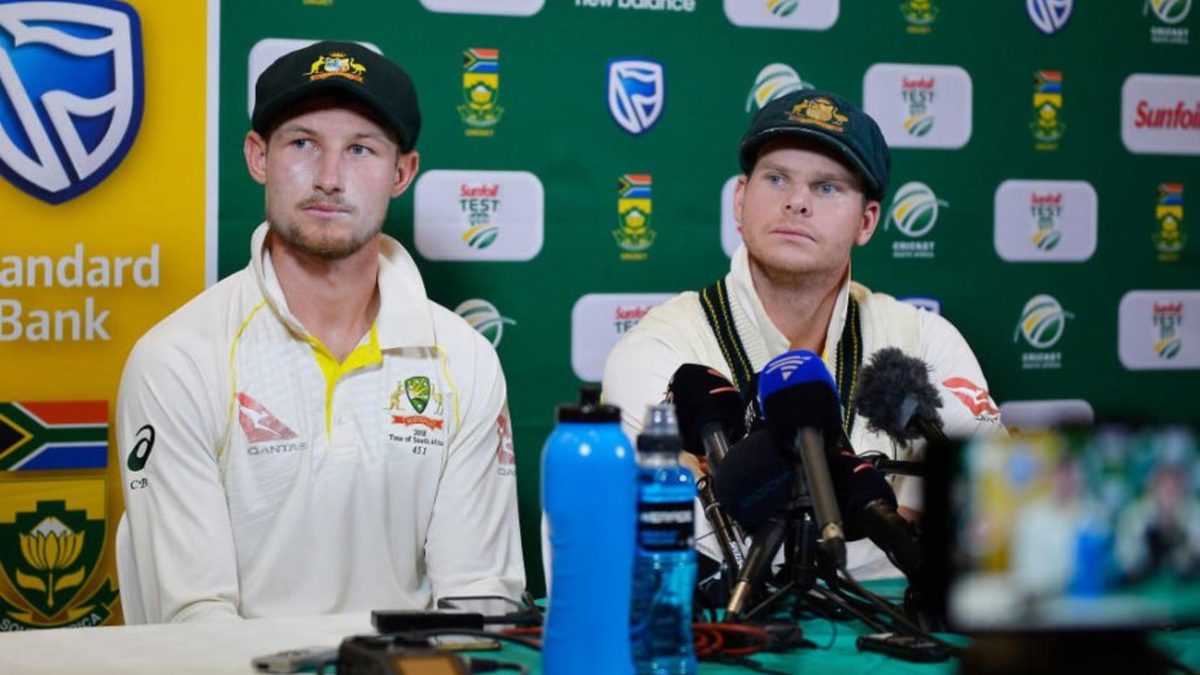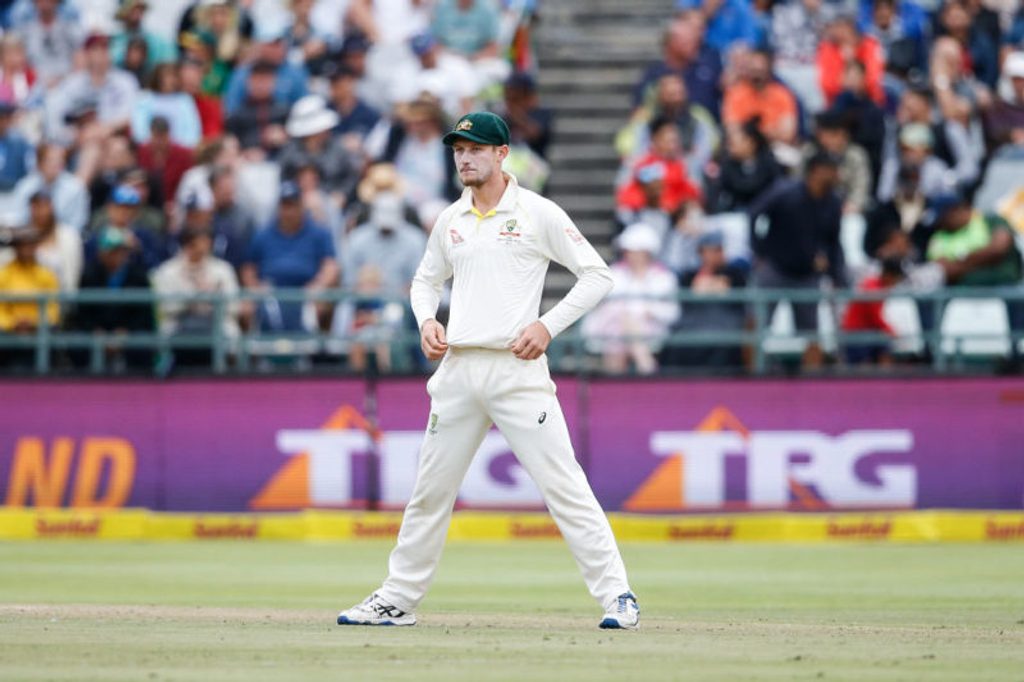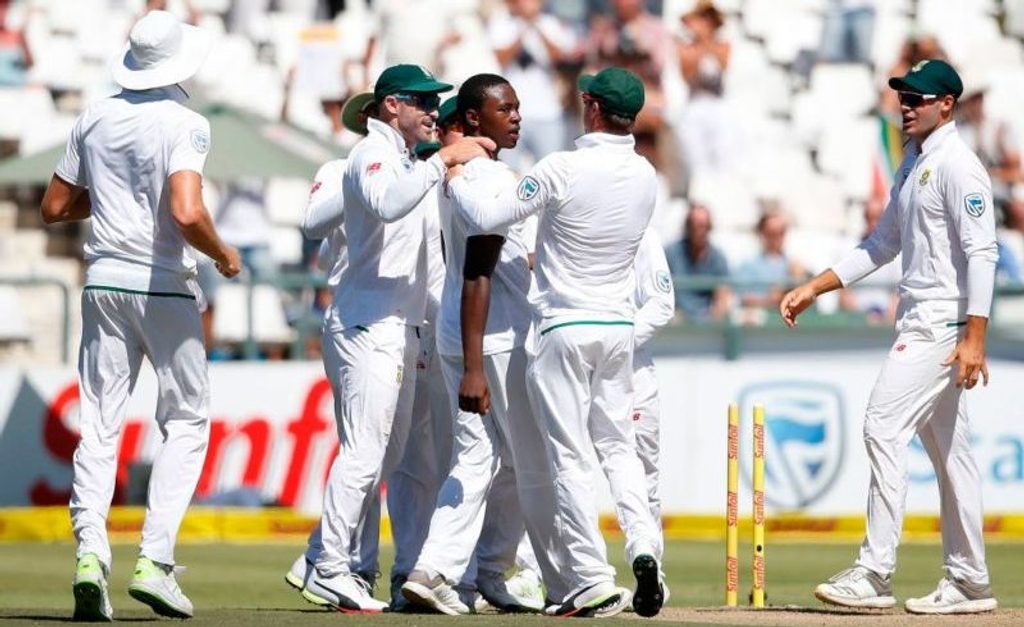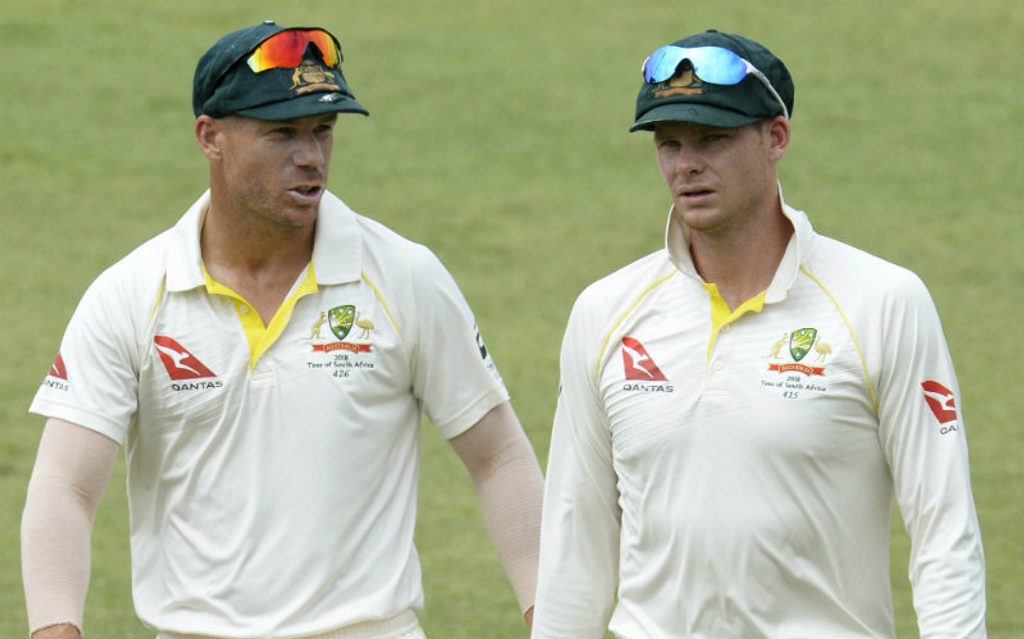
On January 8, 2018, Steve Smith’s Australian team, wreathed in smiles, gathered on what resembled a corny parade float at the Sydney Cricket Ground to celebrate a 4–0 eclipse of England. Smith held the Waterford crystal, flanked by vice-captain David Warner and wicketkeeper Tim Paine; leaning in from the right was Warner’s opening partner, Cameron Bancroft. It is the sort of image that might hang in a cricketer’s home, appear on the cover of a souvenir book, or form part of the opening sequence of a sports-panel show.
The Sandpapergate scandal that engulfed Australian cricket last year was one of the biggest stories in the game’s modern history. In the 2019 Wisden Cricketers’ Almanack, Gideon Haigh considered the row and its aftermath.
On January 8, 2018, Steve Smith’s Australian team, wreathed in smiles, gathered on what resembled a corny parade float at the Sydney Cricket Ground to celebrate a 4–0 eclipse of England. Smith held the Waterford crystal, flanked by vice-captain David Warner and wicketkeeper Tim Paine; leaning in from the right was Warner’s opening partner, Cameron Bancroft. It is the sort of image that might hang in a cricketer’s home, appear on the cover of a souvenir book, or form part of the opening sequence of a sports-panel show.
Yet, its future reproduction will be pervaded by pathos. Here was a glory that could hardly have been more fleeting, pride that could scarcely have come before a steeper fall. Eleven weeks later, revealed to have been part of a scheme to doctor a ball with sandpaper, Smith, Warner and Bancroft would be pariahs; Paine, who 18 months earlier had virtually turned his back on the game, would be captain. Most people had by then forgotten the float, a brainstorm of Cricket Australia’s marketing department. Yet, in hindsight, its jeering naffness looked like the hubris that invites nemesis to spit in its eye.
 Bancroft during the Newlands Test
Bancroft during the Newlands Test
The toll nemesis took at CA may be the heaviest of any controversy in Australian cricket’s annals. Within nine months, Sandpapergate had, directly or indirectly, curtailed the careers of coach Darren Lehmann, chief executive James Sutherland, chairman David Peever, performance chief Pat Howard, integrity officer Iain Roy, and senior directors Bob Every and Mark Taylor.
It had lent Australian cricket the look of English cricket in the 1990s – anxious, introspective, joyless, vulnerable. As their home summer opened in November 2018, Australia were ranked fifth in Tests and sixth in one-day internationals, despite an expensive corporate commitment to ruling the world in all formats. Once the envy of everyone, their system looked as dysfunctional and demoralised as any.
In some eyes, the Australians had been snagged by the sense of exceptionalism cultivated under Taylor, Steve Waugh and Ricky Ponting. Long experience of being top dog, it was argued, and its associations with pushing the boundaries of acceptable aggression, were corrupting. But there was also the simple fact that Australia had turned into rather an ordinary team.
When the ballast of experience provided by Michael Clarke, Brad Haddin, Ryan Harris, Shane Watson and Chris Rogers went overboard in 2015, Australia undertook a remaking for which they seemed to have relatively little patience, aping the structure of XIs past, but without the substance. Taking cues from their coach, players became vigorous proponents of “the Australian way”, espoused like a brand, and of “the line”, a one-dimensional expression of cricket politesse notable for its flexibility. Smith and Warner were the leading performers; they were also among Australia’s most frequent transgressors of the ICC’s Code of Conduct.
In 2017, CA engineered a protracted and mainly pointless confrontation with the players’ trade union over their next collective bargain. The campaign, which aimed to end the Australian Cricketers’ Association’s long-standing direct share in revenue, was closely associated with businessman Peever, and Kevin Roberts, Sutherland’s No.2. It soured to the degree that male and female players were locked out for two months.
An uneasy summer ensued. Against England, Smith and Warner piled up 1,128 runs; there were record crowds and ratings. But, as much as anything, that spoke of the consolations of the Ashes in time of turmoil. Market research for CA discerned an ongoing weakening in the players’ recognisability and like-ability; long-time broadcast partners, the Nine Network and Network 10, were conservative about cricket’s prospects; sponsors were ever less whelmed by their treatment and their returns.
The Australians started their tour of South Africa in late February 2018 full of confidence. In the countries’ two preceding series, reverse swing had been a decisive factor, the Australians suspicious of South Africa’s efforts to expedite it. This time, Lehmann felt relaxed: “Obviously there’s techniques used by both sides to get the ball reversing. That’s just the way the game goes. I have no problem with it. Simple.” Mitchell Starc duly showed himself a master of the craft at Durban, with a match-winning nine for 109.
Victory, however, was soured by gross behaviour on both sides of the boundary, from the Kingsmead crowds toward the Australians, and from the Australians towards their opponents, with the two arguably related. In his familiar role as the team’s provocateur, Warner went about unsettling Quinton de Kock, who appeared to complain to the umpires.
Electronic eavesdropping captured the aftermath as the players left the field for tea: an effects mike heard Warner decry de Kock as a “fucken sook”; a CCTV camera in the stairwell leading to the dressing rooms caught Warner responding angrily to a retort from de Kock which apparently referred to an old incident involving Warner’s wife, Candice, and the rugby star Sonny Bill Williams.
 Rabada was hit with a series ban by the ICC
Rabada was hit with a series ban by the ICC
At Port Elizabeth, where South Africa squared the series thanks to Kagiso Rabada’s own mastery of reverse swing, fans sporting Sonny Bill masks were at first turned away by security, then allowed in by two officers of Cricket South Africa, Clive Eksteen and Altaaf Kazi. Australians seethed again when CSA successfully appealed against a suspension imposed on Rabada for a needless skirmish with Smith.
The Australians went to Cape Town feeling frustrated, embattled, and vaguely paranoid – but just because one is paranoid, as they say, doesn’t mean one is mistaken. Warner was right to suspect that the local broadcaster SuperSport had singled him out for scrutiny of his preparatory rituals of the ball; he was wrong to think that merely passing his duties on would fix the problem. His locum was caught in the act.
Smith’s attempt to head off the issue in a press conference with Bancroft began badly, grew worse, and ended disastrously: they were open and evasive, naive and cynical; they were clearly embarrassed, without being obviously penitent. Australians awoke to the news that their team had cheated in a Test match with the approval of a captain who still thought himself the “right person for the job”. By the afternoon, those who differed included prime minister Malcolm Turnbull: “How can our team be engaged in cheating like this? It beggars belief.”
From time to time, Australian teams have courted unpopularity with their uncompromising competitiveness, but usually there have been some supporters, with cliches about it being “a tough game” and “not tiddlywinks”. The public had now drawn their own line: the Australians – and CA – found themselves on its wrong side. In partial atonement, the board stood Smith and Warner down; when play resumed on the fourth day, Paine was in charge, Howard and Roy en route.
Carrying out his interviews in the aftermath of Australia’s 322-run defeat, Roy recommended charges against captain, vice-captain and Bancroft; although he spared Lehmann, Howard conveyed to the coach that his position was untenable, and he would have to see out his contract at Brisbane’s National Cricket Centre. Institutional and personal sponsors invoked force majeure clauses to sever their ties; the IPL found Smith and Warner too hot to hold; theories abounded for the moral turpitude and the public indignation.
 Smith and Warner were banned for 12 months each, Bancroft for nine
Smith and Warner were banned for 12 months each, Bancroft for nine
When Sutherland arrived in Johannesburg, the scene was set for drastic action: Smith and Warner were banned for 12 months each, Bancroft for nine. Denied their team gear like court-martialled officers stripped of their epaulettes, the three returned to Australia, where they faced media inquisitors in sorrow and contrition.
Having foreshadowed “an independent review into the conduct and culture of our Australian men’s team”, chairman Peever announced “a review of the wider context of the event”, in case “wider cultural, organisational and/or governance issues needed to be addressed”. In the same breath, however, he said he was planning to stay a further three-year term, while Sutherland had the board’s “full support”.
This curious pre-emption effectively put CA’s future on a collision course with their past. While Simon Longstaff of the Ethics Centre began his investigation, the game went through the motions of incremental advance. A broadcast rights deal with the Seven Network and the pay-television venture Foxtel worth $A1.18bn was a boost for morale. Paine was confirmed as captain, Justin Langer anointed coach. In a one-day series in England, a T20 engagement in Zimbabwe and a Test series against Pakistan in the Gulf, there were more snakes than ladders, but at least they were largely out of sight.
Behind the scenes at Jolimont, alliances were shifting. On May 4, without any public explanation or even announcement, CA’s senior-most director Bob Every, a spiky septuagenarian, stepped down, critical in his leaked resignation letter of Peever’s “substandard” chairmanship; four months elapsed before replacement Lachlan Henderson was appointed.
On June 5, Sutherland announced his own resignation, with a notice period of up to a year; four months, including a global search with headhunters Egon Zehnder, were necessary to identify Roberts, his chief operating officer, as his successor, despite his being in the next-door office. Roy accepted a redundancy package; reasons were not given. Howard said he would not seek a further extension of his controversial role, due to end the following year. His decision was said by a spokesman to be “in no way connected to the reviews”.
So what was? Apparently CA’s annual meeting, which fell on October 25, in a baffling order. Twenty minutes after the state associations had unanimously re-elected Peever, they were offered the Ethics Centre’s review to read – heavily redacted, but in an overall sense unsparing: “CA is perceived to say one thing and do another. The most common description of CA is as ‘arrogant and controlling’. The core complaint is that the organisation does not respect anyone other than its own.”
The Centre concluded that the attitude instilled – “winning is the only thing that matters” – had “led players and support staff to ‘redefine’ certain forms of cheating as merely ‘playing hard to win’”. Newlands was therefore “not an aberration”, but “an extreme example of a latent tendency growing out of the prevailing culture of men’s cricket in Australia”, and the result of the grafting on to CA of “a corporate model designed exclusively to generate a profit for the sport’s ‘shareholders’”.
When Peever made the review public three days after his re-election, he struggled to explain how the kind of cultural change the Ethics Centre seemed to be mandating could be achieved without a significant change in personnel – and also why the review, substantially complete for many weeks save for the redactions, had not been available to the state associations in order that they could vote in an informed fashion. A maladroit television interview probably sealed Peever’s fate, inciting a no-confidence push from Cricket NSW’s chairman John Knox – a close friend of Sutherland.
“It is the unfortunate lot of the leader that he or she may sometimes be called upon to sacrifice themselves for the greater good,” the Ethics Centre had noted. On November 1, Peever took the hint, followed the next week by Taylor, wearied by the turn of events. Victorian Earl Eddings, a businessman, became acting-chairman.
As the Australian team took tentative steps into the future, CA took dramatic strides into theirs. Roberts placed his stamp on the board by not only hurrying Howard out of the door, but axing commercial chief Ben Amarfio. Leafing through CA’s 2017-18 annual report, one would hardly have known that the Ashes had been won: Smith’s name was mentioned once in terms of “events in South Africa”, Warner’s and Bancroft’s not at all. And it was now the photographs of the board and executive that were inscribed with pathos: just ten days after the report’s publication, five of the 19 faces depicted were gone.
This article features in the 2019 Wisden Cricketers’ Almanack, which is available to buy here. The most famous sports book in the world has been published every year since 1864.








